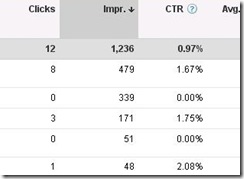Tips
One of the biggest challenges when starting out in an affiliate marketing business is just how to maximize traffic to your affiliate website without spending a lot of money doing so. Last time I discussed free marketing strategies, that have dramatically helped my business. This time I really want to talk about getting the bang for you buck, so to speak, when it comes to pay per click advertising.
The first thought that many of us have is that more is better. By that I mean the more keywords the better your ad will perform. The problem is not really that simple. We want to be able to allow our ads to reach a wide audience but at the same time we wish to have attention from people specifically looking for what we are offering. The bottom line that affects how much we pay when it comes to PPC marketing is the dreaded quality score. What is the quality score? Yahoo and Google are in agreement when it comes to quality score. Google states the following:
“Quality Score is the basis for measuring the quality and relevance of your ads and determining your minimum CPC bid for Google and the search network. This score is determined by your keyword’s click through rate (CTR) on Google, and the relevance of your ad text, keyword, and landing page.”
So, if you take the above statement literally, it is in your best interest to cater to as specific an audience as possible. More practically these are the things that you should think about when writing an ad, selecting keywords, and landing pages.
- Make sure the ad body contains the keywords that you wish to use.
- Make sure the keywords are longer rather than shorter.
- Make sure the landing page also has the keywords within it.
- Keep the number of keywords to 5 or less, if you have more than 5 split the keywords up into separate ads.
- Make ads for specific offers rather than groups of offers
- Stay within compliance when it comes to writing ads and what can appear in the ad body.
- Do not constantly fiddle with ad keywords. Allow them to sit for at least a week before making tweaks.
- Create one ad per ad group.
Note: The landing page is the destination URL that you specify during the creation of your ad.
The more relevant your ad/keyword/landing page relationship is, the higher the quality score will be. An example of this would be:
Green Dot Prepaid Card
Prepaid Gold MasterCard
No Credit Check. Apply Now!
<your display address here>
The wording of the ad body has many elements of what is on the landing page for this particular offer. Thus that point is covered. For keywords you would select things like:
- green dot prepaid credit card
- green dot prepaid debit card
- green dot prepaid credit cards
- green dot prepaid gold mastercard
The reason behind using longer keywords is to basically not compete for the short very expensive keywords. Highly popular keywords will for that very reason have a higher cost per click. Using longer keywords will have two results. The first is the number of impressions that your ad will receive will be fewer. The second result is the clicks that you get as a result will be high quality specific traffic typically resulting in a click through. This in turn increases your click through rate, which will ultimately increase your quality score. A steady high quality score has immediate benefits when it comes to cost per click, as well as your position within search results.
Following what I have mentioned so far has yielded very positive results for my campaigns. This is a snapshot from today. The grey line is the overall count of what was going on, while the lines below are from particular ad groups that I am running. The tips above basically yield high click through rates.
In some instances you may wish to test ad variations before ultimately deciding on one. While I said above that you should create one ad per ad group. This really should only be used for the purpose of testing your keyword/ad body ideas, as it causes your ad variants to compete with each other. I would rather create several different ad groups with the same keywords, or turn off serving optimization for the ad variants. This would be the best way to truly test the ads if you should chose to create several ad variations in an ad group. After a week of tracking ad progress you simply select the best one and get rid of the others. The reason for letting things run for a week or so, is simply due to the fact that demand changes each day, and you really want to collect a full week of data before making choices on ads/keywords.
Keep in mind that things work best when you have control over both sides of your marketing structure. By that I mean, having control over ads/keywords, as well as control over your affiliate website. In my case I only have control over one side my marketing effort. I have control of my ads/keywords, though I will be making necessary suggestions. If I had full control there would be a couple of ideas that I would implement. Those would be:
- Add best performing keywords to the offer landing page.
- Add the best performing keywords to the meta tags for the landing page.
There are other tips that I can note, but I do not have enough personal experimentation with them. Those would be things like:
- Experimenting with different match types
- Use Google Analytics to test landing page/ad performance
Typically exact match wins over broad match, phrase match, or even negatives. I use Google Analytics to track traffic, bounce rate, overall volume, traffic sources, and so on. Google has a great write up on using analytics to test ads, and landing pages. Once I use that feature, I will write about it as well.
Tools
There are very useful tools that are available for use in the creation and maintenance of ads/ad groups. Google has released an Adwords Editor, that is available now in version 7.0.0. It allows you to download your entire CPC campaigns, create new ads, make changes, and post those changes to your campaign all from a desktop application. It also allows exporting and importing. The import stipulation seems to be at least based on a minimum budget amount. I ran into this when exporting my ads from the Adwords Editor, and trying to import those ads into Yahoo. There is a similar stipulation for Google.
I cannot say enough about Google Analytics, but I would have to talk about that in the next post.
Next Post: Tools and Tips
References:
10 Ways To Increase Your Adwords Quality Score at RedFly Marketing
Google Analytics at Google
| Share this post : |  |  |




